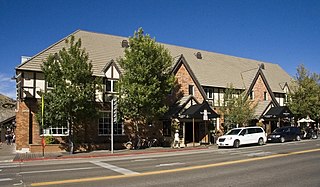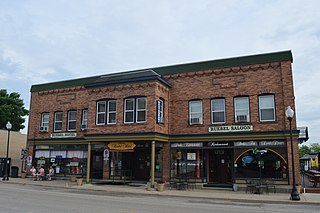
The Old Union Depot Hotel was a historic hotel and commercial building in Tampa, Florida, United States. The building was constructed in 1912 at 858 East Zack Street, directly across Nebraska Avenue from Tampa Union Station. On December 11, 2000, it was added to the U.S. National Register of Historic Places, however, the building was torn down on May 23, 2010.

Pullman National Monument, also known as The Pullman District and Pullman Historic District, is located in Chicago and was the first model, planned industrial community in the United States. The district had its origins in the manufacturing plans and organization of the Pullman Company, and became one of the most well-known company towns in the United States, as well as the scene of the violent 1894 Pullman strike. It was built for George Pullman as a place to produce the famous Pullman sleeping cars.

Central House is an 1860s hotel building located in the 800-person village of Orangeville, in Stephenson County, Illinois, United States. The building was built by Orangeville founder John Bower and operated as a hotel from its construction until the 1930s, when it was converted for use as a single family residence. The three-story building was the first commercial brick structure in downtown Orangeville. Architecturally, the building is cast in a mid-19th-century Italianate style. Central House was added to the U.S. National Register of Historic Places in 1999.

The Battle House Hotel, now known as The Battle House Renaissance Mobile Hotel & Spa, is a historic hotel building in Mobile, Alabama. The current building was built in 1908 and is the second hotel to stand in this location, replacing an earlier Battle House that was built in 1852 and burned down in 1905. It is one of the earliest steel frame structures in Alabama.

11 South LaSalle Street Building or Eleven South LaSalle Street Building is a Chicago Landmark building that is listed on the National Register of Historic Places and that is located at 11 South LaSalle Street in the Loop community area of Chicago, Illinois, United States. This address is located on the southeast corner of LaSalle and Madison Street in Cook County, Illinois across the Madison Street from the One North LaSalle Building. The building sits on a site of a former Roanoke building that once served as a National Weather Service Weather Forecast official climate site and replaced Major Block 1 after the Great Chicago Fire. The current building has incorporated the frontage of other buildings east of the original site of Major Block 1.

The Roberts Riverwalk Hotel and Residence Detroit, formerly the Parke-Davis Research Laboratory also once known as Building 55-Detroit Research, is located on Joseph Campau Street at the Detroit River, in Detroit, Michigan. The former research facility was redeveloped as a boutique luxury hotel located on the Detroit International Riverfront. The building was designated a National Historic Landmark in 1976 for its historic significance as an early research laboratory.

The Carolina Inn is a hotel listed on the National Register of Historic Places on the campus of the University of North Carolina at Chapel Hill in Orange County, North Carolina, which opened in 1924. The Carolina Inn is a member of Historic Hotels of America, the official program of the National Trust for Historic Preservation.

George Washington Memorial Park is located at the center of Jackson, Wyoming. More generally known as "Town Square", the park is notable for its elk-antler arches at each corner of the park, collected from the nearby National Elk Refuge by Boy Scouts and periodically rebuilt. The square originally existed as an open space in the center of town that was made into a park in 1934. The park center also contains a stone memorial to John Colter.

Menor's Ferry was a river ferry that crossed the Snake River near the present-day Moose, Wyoming, United States. The site was homesteaded by Bill Menor in 1892-94, choosing a location where the river flowed in a single channel, rather than the braided stream that characterizes its course in most of Jackson Hole. During the 1890s it was the only homestead west of the river. Menor's homestead included a five-room cabin, a barn, a store, sheds and an icehouse on 148 acres (60 ha), irrigated by a ditch from Cottonwood Creek and at times supplemented by water raised from the Snake River by a waterwheel. Menor operated the ferry until 1918, selling to Maude Noble, who continued operations until 1927, when a bridge was built at Moose.

The Jackson Falls National Register Historic District encompasses the historic village center of Jackson, New Hampshire. It consists of a cluster of buildings centered on the crossing of Jackson Village Road over the Wildcat River, extending on both sides of the river along Five Mile Circuit Road and Carter Notch Road, both of which are part of New Hampshire Route 16B. Most of the properties in the district were built between the 1860s and the 1930s, and are reflective of the community's growth as a summer resort area. The district was listed on the National Register of Historic Places in 2003.

The Wort Hotel was built in downtown Jackson, Wyoming, United States by brothers John and Jess Wort, who were significant figures in the transformation of the economy of Jackson Hole from ranching to tourism. The somewhat Tudor-style building was the first luxury hotel in Jackson. The two-story building features brick facing, with half-timbering and stucco on the second floor and a series of gables facing the street.

There are 69 properties listed on the National Register of Historic Places in Albany, New York, United States. Six are additionally designated as National Historic Landmarks (NHLs), the most of any city in the state after New York City. Another 14 are historic districts, for which 20 of the listings are also contributing properties. Two properties, both buildings, that had been listed in the past but have since been demolished have been delisted; one building that is also no longer extant remains listed.

The historical buildings and structures of Grand Teton National Park include a variety of buildings and built remains that pre-date the establishment of Grand Teton National Park, together with facilities built by the National Park Service to serve park visitors. Many of these places and structures have been placed on the National Register of Historic Places. The pre-Park Service structures include homestead cabins from the earliest settlement of Jackson Hole, working ranches that once covered the valley floor, and dude ranches or guest ranches that catered to the tourist trade that grew up in the 1920s and 1930s, before the park was expanded to encompass nearly all of Jackson Hole. Many of these were incorporated into the park to serve as Park Service personnel housing, or were razed to restore the landscape to a natural appearance. Others continued to function as inholdings under a life estate in which their former owners could continue to use and occupy the property until their death. Other buildings, built in the mountains after the initial establishment of the park in 1929, or in the valley after the park was expanded in 1950, were built by the Park Service to serve park visitors, frequently employing the National Park Service Rustic style of design.

The Baker Hotel is a historic site listed on the National Register of Historic Places located in Baker, Montana, at the southeast corner of Main Street and Railroad Avenue. It was added to the Register on January 5, 2005.
The numerous historic hotels in Meridian, Mississippi, provide insights into the city's growth and expansion, both in the late 19th and early 20th centuries and into the modern age. Many hotels were built in downtown Meridian in the early 1900s to provide lodging for passengers of the railroad, which was essential to the city's growth at the turn of the 20th century. Two of these historic hotels–the Union Hotel, built in 1910, and the Lamar Hotel, built in 1927–have been listed on the National Register of Historic Places.

The Isleton Chinese and Japanese Commercial Districts is located in Isleton, California in the Sacramento–San Joaquin River Delta, a large agricultural area in Sacramento County, California. Also known as the Isleton Asian American District, it served as the commercial and social center for both the town's Chinese and Japanese residents and the laborers working in nearby canneries, farms, and ranches. Isleton Asian American District is the only Asian community built in the Delta during the 1920s, and the architectural style of the buildings in the districts, particularly the use of pressed tin siding, is unique to other Delta Asian communities and to the town of Isleton.

The Ruebel Hotel is a historic hotel located at 207–215 E. Main St. in Grafton, Illinois. Built in 1913, the structure is the second hotel building on the site; the original Ruebel Hotel was built in 1879 and burned down in 1912. The Commercial style building features decorative brickwork typical of the style; the building's cornice has brick corbelling, and raised brick panels decorate the space above the second-story brick arched windows. The hotel, which also included a saloon and a restaurant, gained a reputation as one of the best in Jersey County. It is the only surviving hotel in Grafton.

The Stacey Hotel, at Broadway and College Sts. in Jackson, Kentucky, was built during 1914 to 1920. It was listed on the National Register of Historic Places in 1986.

The Jackson Commercial District in Jackson, Kentucky is a 2.8 acres (1.1 ha) historic district which was listed on the National Register of Historic Places in 1986. The listing included 13 contributing buildings, two non-contributing buildings and two non-contributing sites.

The Gainesville Commercial Historic District in Gainesville, Georgia is a 18 acres (7.3 ha) historic district which is roughly bounded by Broad St., Maple St., Academy St. and Green St. It was listed on the National Register of Historic Places in 2003.




















